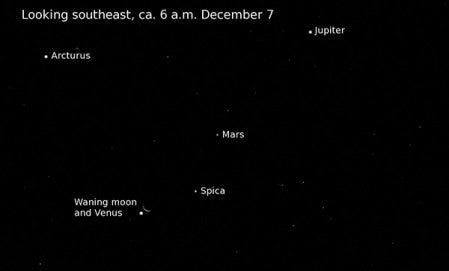Star Watch: View the stars in their winter display
Published 4:01 pm Sunday, November 29, 2015
By Deane Morrison
University of Minnesota
In December the bright winter stars make their grand entrance into the evening sky. Grandest of all is the familiar constellation Orion, clearing the eastern horizon around 8 p.m. Among the stars following Orion are luminous Procyon, harbinger of Sirius, the Dog Star; and finally Sirius, the last and brightest of all. As the days go by, these stars rise earlier, and by January they’ll all be up and shining for us by 9 p.m.
 In the west, the stars of the bright Summer Triangle crowd the northwest horizon. But this is a great time to look for the Milky Way’s closest neighbor, the Andromeda Galaxy. Grab a star chart, go out an hour after sunset, find the Great Square of Pegasus high in the south, and follow the string of three stars extending from its northeastern corner. Above the middle one, the galaxy appears as a faint, fuzzy oval.
In the west, the stars of the bright Summer Triangle crowd the northwest horizon. But this is a great time to look for the Milky Way’s closest neighbor, the Andromeda Galaxy. Grab a star chart, go out an hour after sunset, find the Great Square of Pegasus high in the south, and follow the string of three stars extending from its northeastern corner. Above the middle one, the galaxy appears as a faint, fuzzy oval.
In the morning sky, Venus reigns supreme. Our sister planet will be blazing away in the southeast an hour before sunrise, with Jupiter high in the south. Between these two beacons is reddish Mars, still rather dim but getting higher and brighter as Earth gains on it in the orbital race. Spica, the brightest star in Virgo, spends the month climbing up from near Venus to the vicinity of Mars. Watch the line connecting the three planets stretch as Jupiter climbs ever higher and Venus drops en route to its next swoop behind the sun. On the 7th, don’t miss the close pairing of a crescent moon and Venus.
Winter begins officially at 10:48 p.m. on the 21st, when the Northern Hemisphere is tipped farthest from the sun and the sun shines directly over the Tropic of Capricorn. An observer in space would see the Earth lighted from the Arctic Circle on one hemisphere of the planet to the Antarctic Circle on the opposite hemisphere.
The moon becomes new the morning of the 11th, then begins its trek from west to east across the evening sky. On Christmas Eve a nearly full moon rises in the midst of the bright winter constellations; perfect fullness arrives at 5:11 a.m. on Christmas.
On New Year’s Eve a waning gibbous moon, just one day shy of last quarter phase, rises in the east shortly before midnight. Above the moon shines Jupiter, and above Jupiter the stars of Leo, tilted like a lion poised to spring. Forming Leo’s head is the Sickle, a backwards question mark of stars—fitting punctuation for December 31, when we await a new year not knowing what it will bring.
The University of Minnesota offers public viewings of the night sky at its Duluth and Twin Cities campuses. For more information and viewing schedules, see:
Duluth, Marshall W. Alworth Planetarium: www.d.umn.edu/planet
Twin Cities, Minnesota Institute for Astrophysics (during fall and spring semesters): www.astro.umn.edu/outreach/pubnight.
Check out the astronomy programs at the University of Minnesota’s Bell Museum ExploraDome: www.bellmuseum.umn.edu/ForGroups/ExploraDome/index.htm.
Contact: Deane Morrison, University Relations, (612) 624-2346,morri029@umn.edu
Find U of M astronomers and links to the world of astronomy athttp://www.astro.umn.edu.


